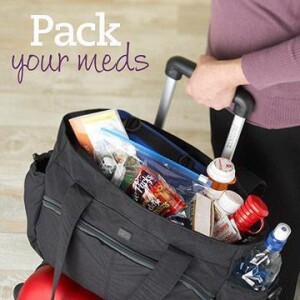


If you have diabetes, preparing for even daily activities can require advanced planning. So how do you prepare for travel, which can disrupt your diabetes care routine? Here are 15 tips for travelling when you have diabetes.
- Increase your stash of supplies. You may be traveling to Hawaii for only a week, but it’s wise to pack diabetes supplies as if you were staying twice as long. Pack more test strips, insulin, syringes, pens and other diabetes equipment than you will need for the trip. If possible, pack a spare meter in case of loss or damage. Pack Needles plus long acting insulin as a backup “just incase”.
- Get documentation. Take clearly written details of emergency contacts plus your National Diabetes Services Scheme (NDSS) card & carry scripts for all medications and make sure they can be easily read with your name, doctors contact details, the name and type of medication.
- Inform airport security you have diabetes. The new full-body scanners and more intrusive pat-down procedures have raised an ongoing controversy about what approaches to take when going through airport security. Pump suppliers say that their products should not go through either the full-body scanners or the normal x-ray machine for carry-on luggage. If you wear a continuous glucose monitoring (CGM) system, that may raise additional concerns in going through security. Again, many CGM manufacturers are warning CGM wearers to avoid exposing your CGM equipment to either the full-body scanner or the x-ray for carry-on baggage. Overall its reported, pump users who have gone through the new security procedures report the hassle factor as ranging from negligible to infuriating.HEREis the current International Transportation Security Administration (TSA) statement about airline security and diabetes supplies: Customs regulations vary from country to country, so it’s advisable to contact the embassy of the country you’re visiting before travelling.
- If you are traveling out of the Australia, we advise, whenever possible to obtain back-ups for your pump or other equipment that you can afford to have fail while you’re out of the country.
- In the Air. Consider disconnecting your Insulin pump during take-off and landing, and priming out any bubble once at cruising altitude. More infoHERE
- Carry Carbs. Carry some form of easily absorbed carbohydrate such as apple juice poppers, dried fruit, muesli bars, biscuits, or jelly beans in case of a hypo, and extra carbohydrate for follow-up treatment. Don’t give your insulin injection or bolus until the meal is served & in case of delay carry extra food. People wishing to carry any Liquids, Aerosols or Gels in their hand luggage onto international flights must carry these items inside a clear one litre (20cm x 20cm) plastic bag. Insulin is a liquid, it will be exempt from this regulation and does NOT need to be carried in the plastic bag, as long as the person carrying it can prove their medical condition, and the insulin is inside its original packaging with the prescription label clearly visible.
Note: Liquids normally 100ml maximum – Exceptions:
- prescribed medicine of any size, non-prescribedmedicine-onlyitems
- baby milk and other items forinfants
- nutrition for diabetesdiet
- You’re Insulin. If flying, keep insulin, syringes/ pens and testing equipment divided between two pieces of hand luggage. Don’t place insulin in your regular luggage, as the plane’s hold is not temperature controlled and luggage may be damaged or lost. Don’t forget to pack your long acting insulin & some syringes when holidaying.
- Just in case. Take a small approved sharps container for used lancets and syringes. Some airlines, hotels and airports offer a sharps disposal service. Carry a small first aid kit with you in case of minor illness or injury.
- Excitement & Stress. The anticipation/stress of a trip or changes in routine may affect your blood glucose levels (BGLs), so you may need to check your BGLs more of ten.
- Try to stick to your routine. Travelling can really throw people with diabetes off schedule, and at no fault of their own. The delay of a flight may mean sitting on the runway for hours, or if you’re traveling out of your time zone, it may mean feeling hungry when you should be asleep. When you have diabetes, you need to think ahead and stick to your routine as much as possible.


- When booking your flights, you may choose to tell the airline that you have diabetes. However, many “diabetic meals” served in flight are too low in carbohydrate and so a standard meal may be more appropriate. It is also recommended that you carry your own supply of portable carbohydrates, in case of unexpected meal delays or if you dislike the meal offered. You can carry as much as you like including Juice poppers as long as it complies with the country you areentering.
- Consider time zone changes. If you’re wearing an insulin pump and will be travelling to a location that is in another time zone, be sure to adjust your insulin pump’s clock to reflect the change. . This is particularly important if you are programming for multiple basal rates; it’s not a good idea for your pump to think it’s in Sydney when your body is in London. If you have questions about how to handle the change, be certain to speak with your diabetes care teambeforehand.
- Test your blood sugar. Travel can have all sorts of effects on diabetes management. For example, when enroute to your destination, you may be sitting for prolonged periods of time. Keep in mind that the lack of activity may prompt your blood glucose levels to become elevated; conversely, sightseeing and other physical activity may lower glucose. Because of the changes in your schedule, it is very important to test glucose before and after meals and you need to be prepared for low glucose whenever it strikes, so pack plenty of glucose tablets— these are usually the best because they won’t melt, explode in heat, or leak and become sticky. If you’re unsure how to correct for highs, ask your healthcare team for moreinformation.
- Discuss your travel plans with your doctor or diabetes educator and make sure you have the letters you will need to comply with airline regulations (see next point). Also, discuss medication adjustments for situations you may encounter, such as diarrhoea and/or nausea. Carry a note from your doctor stating that you have diabetes, and need to have your medication with you at all times. If you’re going to a country where they speak a language other than your own, translate the note into that language. Make a few copies of the note and distribute to those traveling with you, so you will have documentation at alltimes.
- Tell others that you have diabetes. While it may not always be comfortable, it is important to tell the people with whom you are travelling that you have diabetes. Let them know what you have to do to stay healthy and active on your journey, and what they should do in case there is an emergency. Always wear a medical identification bracelet when you’re travelling (although you should be wearing one all of the time anyway)— and be certain that it states you have diabetes, if you take insulin, and if possible, list an emergency contact number. If you’re bringing your mobile phone with you on holiday, be sure to enter a contact in your phone book entitled, “Emergency Contact”—many first responders are trained to look for this in a mobile phone in the event that you are unable to communicate due to an emergencysituation.


SMART TRAVELLER RECOMMENDATIONS– Make sure you are smart travellers before heading overseas. We strongly recommend that you:
Organise comprehensive travel insurance and check what circumstances and activities are not covered by their policy
- Note Australians with Diabetes gain a 20% Policy Premium discount from Donna Barlow Travel Group (DBT & Cruisescene) Phone TOLL Free 1800 678 555 and a they donate 5% back to the DANII Foundation towards Diabetes Education & Management Technology Scholarships. DBT have special arrangementsforDiabetics
Register your travel and contact details with DFAT via the www.smartraveller.gov.au website, so you can be contacted in anemergency
Subscribe to the Smartraveller travel advice for your destination to receive free email updates each time the travel advice for that destination is reissued. Travel advice can be obtained from various sources, including local Governments, local Consular offices, and the Website of the Australian Department of Foreign Affairs and Trade –www.smartraveller.gov.au
TRAVEL DOCTOR – TMVC has clinics all over Australia and NZ and advice on Vaccination & Health requirements with the most up-to-date info:http://www.traveldoctor.com.au/
You can read the Smartraveller advice on Travelling with Medication and Medical Equipment
Enhanced Security Measures-The Transport Security Administration in the United States, United Kingdom and a number of other countries governments have implemented enhanced security measures at select overseas airports with direct flights to the U.S. and UK. Passengers are being advised to ensure that all their electronic devices, such as mobile phones, iPads, tablet and laptop computers, are charged before they travel for testing and inspection prior to boarding. Devices that do not power on may not be permitted on board the aircraft. Passengers should also allow additional time for security screening. It is recommended to remove Insulin Pumps and not go through full body screening. Present your letter from your Doctor when requesting exemption from a full body scan.


